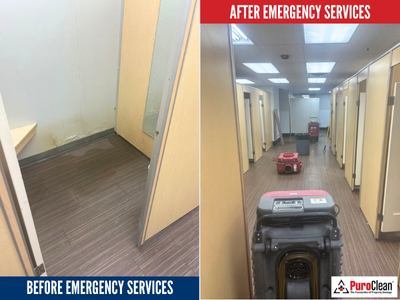Table of Contents
The flames may be out, but the dangers are far from over. After a house fire, homeowners are often surprised to find that smoke and soot create more lasting damage than the fire itself. Odors seep deep into walls, fabrics, and HVAC systems, while soot leaves behind toxic residue that can affect both property and health. That’s why smoke damage restoration is one of the most urgent steps you can take after a fire.
At PuroClean of Downtown Chicago, we’ve guided countless families through the aftermath of residential fires. In this guide, we’ll explain exactly what to do after a house fire, why smoke damage restoration matters, and how to protect your home, belongings, and well-being.
Step 1: Make Safety the Priority
Even if the fire is extinguished, the environment inside your home may still be hazardous.
- Avoid re-entering your home until cleared by fire officials.
- Use protective gear (like masks and gloves) if you must enter briefly.
- Keep children, pets, and vulnerable family members away until restoration begins.
Smoke contains fine particles that are invisible to the eye but harmful to breathe in — especially for those with asthma, allergies, or other respiratory conditions.
Step 2: Contact Your Insurance Company Immediately
Time is critical for insurance claims. Call your provider as soon as possible to report smoke damage.
- Ask about your coverage for smoke damage restoration.
- Request guidance on documenting losses.
- Save receipts for hotel stays, meals, or emergency repairs — these may be reimbursable.
Tip: Don’t dispose of damaged items until your adjuster has inspected them.
Step 3: Document All Damage Thoroughly
Before restoration begins, take time to record the full extent of the damage.
- Photograph every affected room and surface.
- Create a written inventory of personal belongings.
- Record odors and discoloration that might not be obvious in photos.
Documentation ensures your claim is comprehensive and speeds up the restoration process.
Step 4: Understand the Health Risks of Smoke Damage
Many homeowners underestimate the long-term risks of smoke exposure. Left untreated, smoke residue can cause:
- Respiratory problems and chronic coughing
- Eye, skin, and throat irritation
- Worsening of asthma or allergies
- Long-term structural damage due to corrosion
Soot and smoke contain toxic chemicals from burned plastics, wood, and household materials. Professional smoke damage restoration ensures these contaminants are removed safely.
Step 5: Don’t Attempt DIY Cleanup
Wiping soot with the wrong cleaner or cloth can make stains permanent. Store-bought sprays often mask odors without removing the source.
Professional smoke damage restoration involves:
- HEPA air filtration to remove harmful particles
- Thermal fogging or ozone treatment to neutralize odors
- Dry sponging and specialized cleaners to safely remove soot
- HVAC cleaning to stop smoke from circulating through vents
Learn more about our fire damage restoration process.
Step 6: Address Water Damage Alongside Smoke Cleanup
Where there’s fire, there’s often water — from firefighting hoses, sprinklers, or suppression systems. Standing water can quickly lead to mold growth, making cleanup even more urgent.
At PuroClean of Downtown Chicago, we provide both smoke damage restoration and water damage restoration to ensure your home is fully restored, not just partially cleaned.
Step 7: Restore Belongings and Personal Items
One of the most difficult parts of recovery is the potential loss of personal belongings. Fortunately, many items can be restored with professional cleaning.
Commonly Restored Items Include:
- Furniture and upholstery
- Clothing, drapes, and linens
- Electronics (if treated quickly)
- Family heirlooms, photos, and keepsakes
Specialized content cleaning services give homeowners hope that not everything is lost.
Step 8: Use Reconstruction When Needed
Some homes require more than cleaning — they need rebuilding. At PuroClean of Downtown Chicago, we provide reconstruction services to restore your property to pre-loss condition, from drywall repair to full-scale structural rebuilding.
Step 9: Protect Your Health During and After Restoration
During smoke damage restoration, continue to protect your family:
- Use air purifiers in unaffected areas of the home.
- Wash clothing and bedding thoroughly before reuse.
- Schedule HVAC inspections before running heating or cooling systems.
Your health and safety are just as important as restoring the property itself.
Step 10: Partner With a Professional Smoke Damage Restoration Company
When disaster strikes, having the right restoration partner makes all the difference. At PuroClean of Downtown Chicago, our smoke damage restoration services include:
- 24/7 emergency response
- Soot and smoke residue removal
- Advanced odor elimination techniques
- Air purification and HVAC cleaning
- Full property reconstruction when necessary
See what customers in Downtown Chicago are saying about us on Google.
Conclusion
The question, “What should I do immediately after smoke damage in my home?” has one clear answer: act fast, stay safe, and call professionals who know how to handle the job.
At PuroClean of Downtown Chicago, we take pride in restoring not only your property but also your peace of mind. With our proven smoke damage restoration process, your home can be safe, clean, and livable again — faster than you may think.




